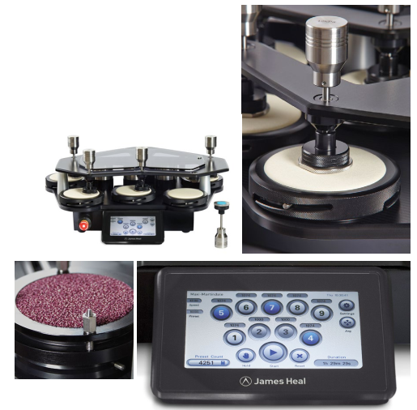Light Fastness Test

Q: Which Test Methods refer to hours/time and which Methods refer to Blue Wool References?
A: Most textile standards are based on blue wools, whereas many automotive standards are based on dosage of radiation (time). Controlled irradiance is needed for this type of testing, so a radiometer like James Heal’s SolarSens is required. ISO 105 B02 – Method 5 refers to irradiance dosage.
Q: At what frequency should users be changing Xenon Lamps, KG1 Filters, Borosilicate Cylinder and Air Filters?
A: Lamps: change at approximately 1500 hours of testing when run at ISO 105 B02 A1
KG1 Filters: change at 3500 hours of testing
Borosilicate Cylinder: This has no lifespan so doesn’t require changing, just keep it clean and undamaged
Air filters are environment dependent
Q: Can you explain the main difference between ISO 105 B02 Method 2 and Method 5?
A: Method 2 uses blue wools, it is described in the standard as, ‘This method is used when a large number of specimens have to be tested simultaneously. It allows a number of specimens differing in colour fastness to be tested against a single set of blue wool references, thus conserving supplies.’ Method 5 is based on dosage of radiation (time), the standard states, ‘This method is suitable to check conformity to agreed-upon radiant energy levels.’
Q: What is the difference between Black Panel Thermometer and Black Standard Thermometer?
A: The temperature indicated by the black-panel or black-standard thermometer depends on the irradiance produced by the apparatus light source and the temperature and speed of the air moving in the test chamber.
Black-standard thermometer (as favoured by ISO) temperatures generally correspond to those for the exposed surface of dark samples with poor thermal conductivity.
Black-panel thermometer (as favoured by AATCC) temperatures generally correspond to those for dark coatings on metal panels. AATCC 16.3 Option 3 Uses this and light fastness customers specify this most frequently at conditions used in typical exposure tests, the temperature indicated by a black-standard thermometer will be higher than that indicated by a black-panel thermometer.
Because black-standard thermometers are insulated, their response time for temperature changes is slightly slower than for a black-panel thermometer. You can see the physical differences on the graphic below:





